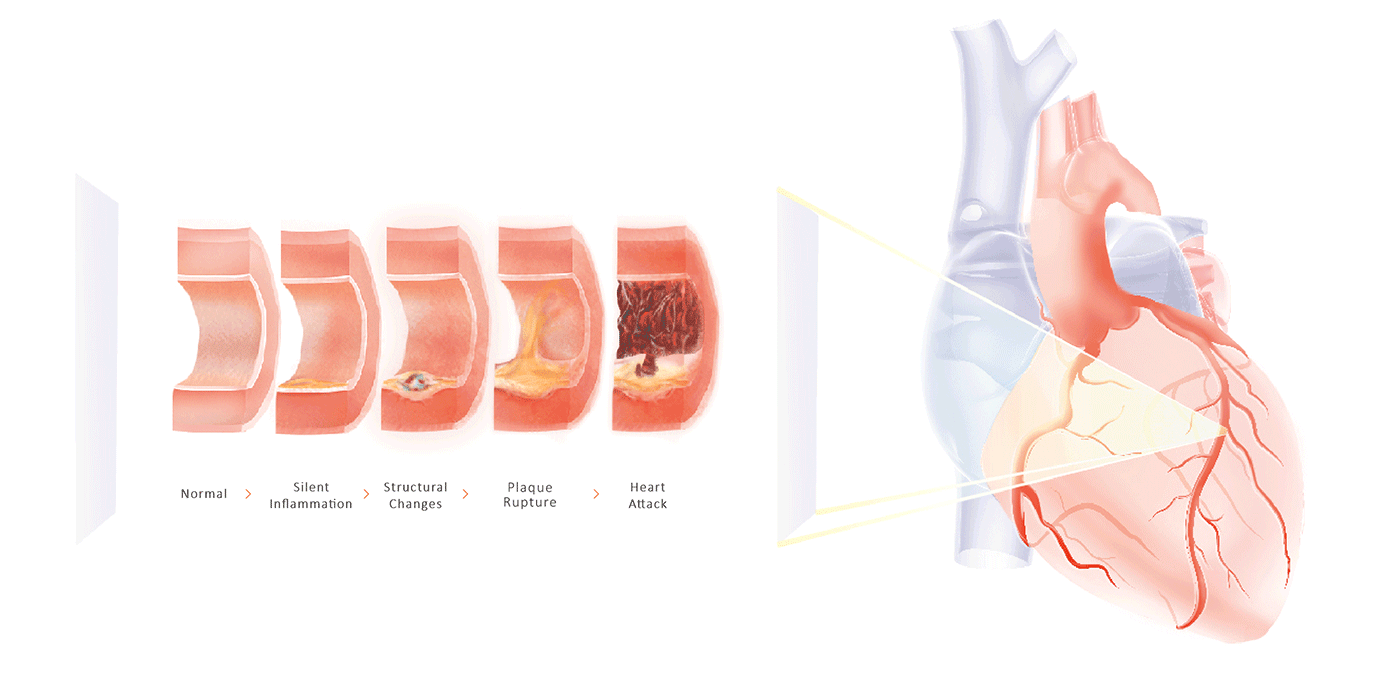
Take a look at our patient resources that are created to help you understand your heart condition better. Our brochures and leaflets have information on the science behind our technology, how the CaRi-Heart® analysis is conducted and what to expect from the diagnosis.
Clinicians can order patient brochures to discuss whether a CaRi-Heart® analysis would be appropriate for the patient.
Order Patient Brochures for your clinicCardiovascular diseases are the leading worldwide cause of death.
The commonest form is Coronary Artery Disease (CAD) affecting the arteries on the surface of the heart, which supply blood to the heart muscle.
Through an inflammatory process, called atherosclerosis, cholesterol is deposited in the wall of these arteries, which causes build-up of localised narrowings called “plaques”. This progressively reduces blood flow, especially during exertion, which can result in chest pain (called angina).
Inflammation in the arterial wall can weaken the surface of a plaque, leading to its sudden rupture and resulting in a blood clot which may block the artery and cause a heart attack or even sudden death, even when blood flow was not significantly reduced before.

Over time, CAD can weaken the heart muscle. This may lead to heart failure, a serious condition where the heart can’t pump as much blood as the body needs.
The same arterial disease often occurs in other important arteries in the body, such as those supplying the brain, and can lead to a stroke.
The major risk factors for CAD are known and include high cholesterol levels, high blood pressure, smoking, diabetes and family history. Alcohol, stress, diet, obesity and lack of fitness are also important.
Managing these risk factors with a healthy lifestyle (such as reduced alcohol intake, smoking cessation and regular physical activity), and where necessary medications, can help reduce your future risk of developing CAD and its complications.
The most common symptom of CAD is angina, which causes tightness in the chest often described as squeezing.
Symptoms of a heart attack include chest pain, which is often severe but may also feel like indigestion or heartburn, upper back or neck pain, cold sweat, dizziness or nausea, vomiting, extreme fatigue and shortness of breath.
If you have symptoms, or important risk factors, your doctor may wish to determine the extent and pattern of your coronary artery disease, to provide best advice on your care.
Inflammation cannot be detected by current tests, which aim at identifying the degree of narrowing of coronary arteries, and their impact on blood flow. Unfortunately, close to 2/3 of all heart attacks occur in arteries that were not significantly narrowed before a plaque rupture caused the event.
Caristo has developed a new technology that analyses images of a routine test called Coronary Computed Tomography Angiography (CCTA) to quantify the extent of inflammation in the coronary arteries. Large scientific studies in thousands of patients have shown that Caristo’s technology can detect inflammation before narrowings have developed in the coronary arteries.
When incorporating this information into the CaRi-Heart® Risk, close to 1/3 of patients have their future risk of having a heart attack or dying from a heart-related condition reevaluated: In 15% of the cases to a lower risk, in 16% of the cases to a HIGHER risk.
This means your doctor will be able to better define the most appropriate treatment for you to prevent future heart attacks or avoid unnecessary medication and associated side effects.
Computed tomography, more commonly known as a CT or CAT scan, is a diagnostic medical imaging test that produces multiple images of the inside of the body with x-rays. The CT scanner is a large, donut-shaped machine with a short tunnel in the center. You will be lying on a bed table that slides into it.

Coronary CT Angiography (CCTA), also known as cardiac CT scanning, uses an intravenous (IV) injection of iodine-containing contrast material to generate high-resolution images of the coronary arteries and the heart.
Your primary care physician or cardiac specialist will determine whether CCTA is an appropriate test for you.
A nurse or technologist may ask you to remove your clothes above the waist and wear a hospital gown. You may be asked to remove metal objects such as jewelry, which can affect the CT images.
You will be asked to lie on your back on the scanner bed table. While you may lie on this table for approximately 10 – 30 minutes, most of this time will involve preparation. The actual images only take a few seconds to obtain.
An intravenous (IV) line will be inserted into a vein in your arm. Nitroglycerin may also be given as a tablet or a spray underneath your tongue, to widen the coronary arteries and improve the pictures. This may cause a temporary slight headache.
The technologist or nurse will apply sticky patches called electrodes on your chest. This will be used to monitor your heartbeat during the exam.
You will be asked to lie still and will receive instructions to hold your breath for short periods of time (less than 15 seconds) while pictures are taken. It is very important to be absolutely still and to not breathe, move or swallow while the pictures are being taken.
During some steps of the test, contrast dye will be injected through the IV. This may cause a warm feeling all over your body, which usually disappears within a minute or so.
Provided by the Society of Cardiovascular Computed Tomography (SCCT). For more information click here.
Based upon your condition and the doctor performing the CTA, you may be asked to do the following – always check with your doctor for your preparation before the test:
Provided by the Society of Cardiovascular Computed Tomography (SCCT). For more information click here.
Your doctor will be able to look at your coronary arteries to see whether there is any disease and if so, what the extent of it is.
The images will show everything your doctor needs to know such as the degree of narrowing, amount of calcification or level of plaque burden. They can also be sent to Caristo to measure inflammation around the coronary arteries.
With this comprehensive information, your doctor will be able to select the best treatment for you.